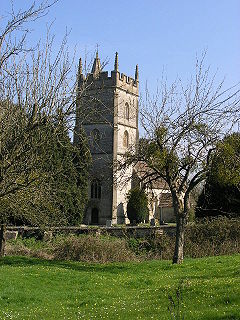
Summary
Pylle is a village and civil parish 4 miles (6.4 km) south west of Shepton Mallet, and 7 miles (11.3 km) from Wells, in the Mendip district of Somerset, England. It has a population of 160.[1] The parish includes the hamlet of Street on the Fosse.
| Pylle | |
|---|---|
 | |
 Pylle Location within Somerset | |
| Population | 160 (2011)[1] |
| OS grid reference | ST605385 |
| District | |
| Shire county | |
| Region | |
| Country | England |
| Sovereign state | United Kingdom |
| Post town | SHEPTON MALLET |
| Postcode district | BA4 |
| Dialling code | 01749 |
| Police | Avon and Somerset |
| Fire | Devon and Somerset |
| Ambulance | South Western |
| UK Parliament | |
The village is very close to the site of the Glastonbury Festival.
History edit
At the time of the Domesday Book in 1086 the tenant was Serlo de Burci from whom the manor passed by 1303 to William FitzMartin.[2] Pylle subsequently became a possession of the Berkeley family of Bruton Abbey in Somerset, a junior branch of Berkeley of Berkeley Castle in Gloucestershire. It was the paternal inheritance received by Sir Edward Berkeley (1580-1654), the third son of Sir Henry Berkeley (1541-1601) of Bruton. His grandson Edward Berkeley (c.1644-1707), of Pylle, served three times as a Member of Parliament for Wells in Somerset.[3] William Berkeley (d.1737) of Pylle changed his surname to Portman on becoming heir to his distant cousin Sir William Portman, 6th Baronet (d.1690) of Orchard Portman in Somerset.[4] His descendant was Edward Berkeley Portman, 1st Viscount Portman (1799-1888).
Pylle fell within the tithing of Pylle, the hundred of Whitstone,[5] the registration district of Mendip, previously within Shepton Mallet until 1936.
Pylle railway station was a station on the Highbridge branch of the Somerset and Dorset Joint Railway. It opened in 1862 and closed in 1966.
Governance edit
The parish council has responsibility for local issues, including setting an annual precept (local rate) to cover the council’s operating costs and producing annual accounts for public scrutiny. The parish council evaluates local planning applications and works with the local police, district council officers, and neighbourhood watch groups on matters of crime, security, and traffic. The parish council's role also includes initiating projects for the maintenance and repair of parish facilities, as well as consulting with the district council on the maintenance, repair, and improvement of highways, drainage, footpaths, public transport, and street cleaning. Conservation matters (including trees and listed buildings) and environmental issues are also the responsibility of the council.
The village falls within the Non-metropolitan district of Mendip, which was formed on 1 April 1974 under the Local Government Act 1972, having previously been part of Shepton Mallet Rural District,[6] which is responsible for local planning and building control, local roads, council housing, environmental health, markets and fairs, refuse collection and recycling, cemeteries and crematoria, leisure services, parks, and tourism.
Somerset County Council is responsible for running the largest and most expensive local services such as education, social services, libraries, main roads, public transport, policing and fire services, trading standards, waste disposal and strategic planning.
It is also part of the Somerton and Frome county constituency represented in the House of Commons of the Parliament of the United Kingdom. It elects one Member of Parliament (MP) by the first past the post system of election.
Landmarks edit
Pylle Manor probably dates from the 17th century, with an 18th-century staircase, and is also listed as a Grade II* building.[7]
Religious sites edit
The Church of St Thomas à Becket was rebuilt in 1868 for the Portman family of Orchard Portman, but a 15th-century tower from the earlier church remains. It is designated as a Grade II* listed building.[8]
References edit
- ^ a b "Pylle Parish". Neighbourhood Statistics. Office for National Statistics. Retrieved 1 January 2014.
- ^ Bush, Robin (1994). Somerset: The Complete Guide. Dovecote Press. pp. 172. ISBN 1-874336-26-1.
- ^ BERKELEY, Edward (c.1644-1707), of Pylle, nr. Wells, Som., History of Parliament: the House of Commons 1690-1715, ed. D. Hayton, E. Cruickshanks, S. Handley, 2002[1]
- ^ Deed Poll Office: Private Act of Parliament 1735 (9 Geo. 2). c. 22
- ^ "Somerset Hundreds". GENUKI. Retrieved 22 October 2011.
- ^ "Shepton Mallet RD". A vision of Britain Through Time. University of Portsmouth. Retrieved 4 January 2014.
- ^ Historic England. "Pylle Manor (1058786)". National Heritage List for England. Retrieved 25 November 2006.
- ^ Historic England. "Church of St Thomas a Beckett (1175680)". National Heritage List for England. Retrieved 25 November 2006.
External links edit
- Somerset Archive & Record Service summary of holdings for parish of Pylle
- Transcription of Pylle, Somerset - marriages 1591 to 1799


